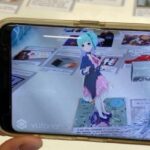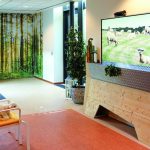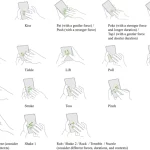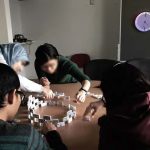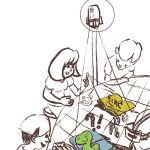With increasing research attention on the application of Augmented Reality (AR) and Game elements in education, fantasy elements as imaginary, fictional game features have been shown to improve learners’ motivation and are critical to engaging and immersive experiences in AR game-based learning. With its affordance of enriching real-life education with virtual effects, AR game-based learning has shown its potential to improve recall performance in previous research. However, educators and researchers have concerns regarding the effect of employing fantasy game elements in AR game-based learning, suggesting learning with such elements will add cognitive load for children leading to a lower recall. To explore the effect of AR and fantasy in game-based learning for recalling declarative knowledge, we conducted an experiment involving 98 children participants and 26 adult participants from the Netherlands and China, using our own designed AR game- ChemiKami AR. We used a mixed ANOVA to identify the effect of fantasy and AR on knowledge recall. This study showed that using AR fantasy in game-based learning can improve recall of declarative knowledge and increase learning effectiveness in classroom learning contexts for children. We offer insights and guidelines for designing AR and fantasy experiences that enhance declarative knowledge recall for target groups with different ages, learning capacities, and cultural backgrounds.
Author: hj
Social Balance Ball: Designing and Evaluating an Exergame That Promotes Social Interaction between Older and Younger Players
As the population ages rapidly, there is a strong focus on the healthy aging of older adults. A central part of healthy aging is keeping people connected in later social life. Exergames are recommended as one of the coping strategies to help improve health and quality of life in older adults. In our study, we developed an exergame called Social Balance Ball to engage older and younger people to play together, encouraging social interaction between generations. From May to July 2021, we evaluated this exergame in Shanghai, China, performing a user experiment with 18 unfamiliar young-old pairs under three test conditions (virtual player, mediated human player, and o-located human player). To evaluate the exergame, our main findings demonstrated that participants felt significantly perceived social interaction in mediated play and co-located play than in virtual play. Overall, older participants perceived significantly higher social interaction than younger participants. In this study, we contribute (1) empirical research findings on how the SocialBalance Ball exergame enhances social interaction in generations; (2) design implications for informing future design and development of social exergames
Designing with Fantasy in Augmented Reality Games for Learning
PhD Thesis, Tengjia Zuo
Contemporary young generations face numerous 21st-century learning challenges. Young students living in a technologically and information-rich culture benefit from advances in educational technology yet are distracted by the clutter that information technology brings. Previous work suggested that educators showed concerns about the effect of learning with digital technology in schools, and many students were disengaged and unsatisfied with e-learning environments.
Technology Boosts People with Dementia’s Psychosocial Well-being
Yuan Feng gained her PhD Cum Laude at the department of Industrial Design on July 7th 2022. See the original article on TU/e website by Nicole van Overveld (Communication Advisor)
The PhD-research of Yuan Feng focuses on promoting the well-being of a vulnerable population in our society – people with dementia – using interactive technologies. Collaborating with the Vitalis Berckelhof, a Dutch residential care for elderly with and without dementia located in Eindhoven, Feng gave clients living there a way to relive the pasts and get closer to outdoor nature through simulated sensory experiences with rich interaction possibilities.
Enhancing Social Interaction among Nursing Homes Residents with Interactive Public Display Systems
Kai Kang, Bart Hengeveld, Caroline Hummels, Jun Hu
Positive peer interaction in nursing homes has been consistently recognized as essential to residents’ life quality. However, low rates of resident-to-resident interaction were found to be pervasive. Our research explores the potential of applying public display systems to promote residents’ unplanned co-located interaction. This article describes the design and assessment of “Reading-to-Sharing” (R2S): a tabletop display system intended to improve nursing home residents’ social interaction by enhancing their public reading experience. R2S was assessed via supervised field trials, in which the participants were invited to experience R2S in real-life settings with necessary assistance. The objectives were mainly to investigate the participants’ engagement with R2S, user experience and the potential impact on residents’ social behaviors and feelings. The result showed that R2S was capable of engaging the participants in content viewing and sharing. It was effective in catalyzing and facilitating their social interaction. The participants’ perceived user experience was primarily favorable. Although R2S was anticipated to increase the participants’ mutual closeness, no statistically significant change was seen. The key implications were highlighted to guide the design of public display systems in this context.
FULLTEXT: PDF REFERENCE: BibTeX EndNote
DOI: 10.1080/10447318.2021.2016234
User-defined gestures for mediated social touch on touchscreens
Qianhui Wei, Jun Hu & Min Li
Mediated social touch is a new form of remote communication. Some researchers designed prototypes to deliver mediated social touch for mobile devices. However, there lacks a comprehensive analysis of the user-defined gestures of mediated social touch on touchscreens of mobile devices. We conducted an elicitation study for 24 social touch gestures on the touchscreen of smartphones and recorded physical parameters. We developed a user-defined gesture set considering physical properties and context. We provided classifications based on the movement forms. We found that social touch gestures with shorter duration were easier for participants to perform; participants were inclined to use social touch with an easier gesture more often. Participants were more likely to express happy or sad expressions rather than neutral emotions. Based on the findings, we discussed the implications for mediated social touch technology and its application on touchscreens.
FULLTEXT: PDF REFERENCE: BibTeX EndNote
DOI: 10.3390/info13020063
AffectiveViz: Designing Collective Stress Related Visualization
PhD Thesis, Mengru Xue
Stress is a cultural phenomenon that is socially distributed in organizations. Collective stress, the stress within a group or an organization, describes the stress perceived by the whole group or organization. Similar to individual stress, excessive collective stress may affect individuals’ health as well as social collaborations, so the management of these stressors is equally essential. Current solutions for collective stress are mainly distributed in the social psychology field. These approaches contain subjective bias, require specific attention, and can hardly be applied in office workers’ busy working routines. With the aid of technologies, Human-Computer Interaction (HCI) researchers provide users with actionable, data-driven self-insight to help them change their behavioral patterns for wellbeing. However, such technological interventions are mainly designed for individual stress management instead of a workgroup. Therefore, we see an opportunity to use technology to facilitate people to catch every nuance of change, to balance the subjective bias, and to improve office workers’ understanding of collective stress toward coping with it.
Research on Stress and Collective Stress
On collective stress:
M. Xue, AffectiveViz: Designing Collective Stress Related Visualization, PhD Thesis, Department of Industrial Design, Eindhoven University of Technology, Eindhoven, 2021.
FULLTEXT: PDF REFERENCE: BibTeX EndNote
M. Hoekstra, P.-l. Lu, T. Lyu, B. Zhang, and J. Hu, “Collective Stress Visualization Enabled by Smart Cushions for Office Chairs,” Distributed, Ambient and Pervasive Interactions. Smart Environments, Ecosystems, and Cities, HCII 2022, Lecture Notes in Computer Science Series, 13325, pp. 278-290, Cham: Springer International Publishing, 2022.
FULLTEXT: PDF REFERENCE: BibTeX EndNote
DOI: 10.1007/978-3-031-05463-1_20
D. Stappers, Investigating Collective Stress – Behavioral Influences Amongst Office Workers by a Dynamic Painting, M12 Project Report, Department of Industrial Design, Eindhoven University of Technology, Eindhoven, 2022.
FULLTEXT: PDF
G. Valkenburg, THE WINDOW TO RELIEF – Reducing collective stress at the office, FBP Project Report, Department of Industrial Design, Eindhoven University of Technology, Eindhoven, 2022.
FULLTEXT: PDF
M. Xue, R.-H. Liang, J. Hu, B. Yu, and L. Feijs, “Understanding How Group Workers Reflect on Organizational Stress with a Shared, Anonymous Heart Rate Variability Data Visualization,” in CHI Conference on Human Factors in Computing Systems Extended Abstracts, New Orleans, LA, USA, 2022, pp. Article 27.
FULLTEXT: PDF REFERENCE: BibTeX EndNote
DOI: 10.1145/3491101.3503576
M. Hoekstra, Bringing valuable insights to office environments by visualizing health–data, FMP Report, Department of Industrial Design, Eindhoven University of Technology, Eindhoven, 2021.
FULLTEXT: PDF
J. Buining, and Y. Miao, Less Collective Stress, Better Workspace, B2 Project Report, Department of Industrial Design, Eindhoven University of Technology, Eindhoven, 2021.
FULLTEXT: PDF
M. Xue, R. Liang, B. Yu, M. Funk, J. Hu, and L. Feijs, “AffectiveWall: Designing Collective Stress-Related Physiological Data Visualization for Reflection,” IEEE Access, vol. 7, pp. 131289-131303, 2019.
FULLTEXT: PDF REFERENCE: BibTeX EndNote
DOI: 10.1109/ACCESS.2019.2940866
M. Xue, R.-H. Liang, J. Hu, and L. Feijs, “ClockViz: Designing Public Visualization for Coping with Collective Stress in Teamwork,” Proceedings of the Conference on Design and Semantics of Form and Movement – Sense and Sensitivity, DeSForM 2017, Series, M. B. Alonso and E. Ozcan, eds., pp. 67-78, Rijeka: InTech, 2017.
FULLTEXT: PDF REFERENCE: BibTeX EndNote
DOI: 10.5772/intechopen.71220
Design Guidelines for Augmented Reality Serious Games for Children
PhD Thesis, Jingya Li
Today’s children are born in a world with rapid growth of multimedia technologies and are used to handling all kinds of digital devices, they furthermore appear to be attracted to digital games and spend a lot of time with them. Consequently, digital games for educational purposes, also known as serious games, have become an increasingly important method for learning and instruction. However, empirical evidence of serious games being more motivating is still lacking, and as many serious games focus on single-player instruction, serious gameplay can sometimes be a physically and socially isolating experience.
Bringing valuable insights to office environments by visualizing health–data
FMP project by Matthijs Hoekstra
… Hangzhou Bobo is developing a sensor which can be implemented in, for example, an office chair. This sensor can measure several health-related data and thus can provide an employee with direct feedback and insights … Hangzhou Bobo is currently pre-occupied with creating a relationship with SUNON a Chinese office equipment producing company within China. For this partnership, there is an integrated value proposition for the sensor detailing the design and technology. This proposition is solely focused on the Chinese market and therefore not adapted to any countries outside of China. As indicated by others, companies operating in different market networks (e.g. Europe and China) need to adjust their strategies to be successful, as the context can differ both on a cultural level. Thus, it is necessary to change the current proposition into an adapted one for the European market; this, therefore, includes exploring the business landscape in Europe and defining new (design) directions for using the data in office environments in the EU.
FULLTEXT: PDF
